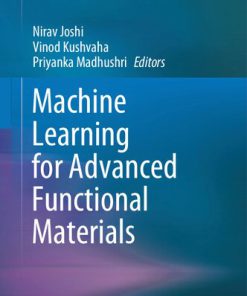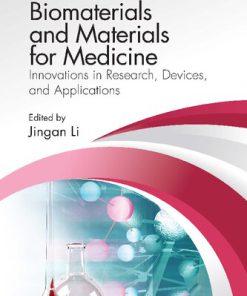Functional Tactile Sensors Materials Devices and Integrations 1st Edition by Ye Zhou, Ho Hsiu Chou ISBN 0128206330 9780128206331
$50.00 Original price was: $50.00.$25.00Current price is: $25.00.
Functional Tactile Sensors Materials Devices and Integrations 1st Edition by Ye Zhou, Ho Hsiu Chou – Ebook PDF Instant Download/Delivery: 0128206330 ,9780128206331
Full download Functional Tactile Sensors Materials Devices and Integrations 1st Edition after payment

Product details:
ISBN 10: 0128206330
ISBN 13: 9780128206331
Author: Ye Zhou, Ho Hsiu Chou
Functional Tactile Sensors: Materials, Devices and Integrations focuses on the subject of novel materials design and device integration of tactile sensors for functional applications. The book addresses the design, materials characteristics, device operation principles, specialized device application and mechanisms of the latest reported tactile sensors. The emphasis of the book lies in the materials science aspects of tactile sensors—understanding the relationship between material properties and device performance. It will be an ideal resource for researchers working in materials science, engineering and physics.
Includes the latest advances and recent developments in tactile sensors for artificial intelligence applications
Reviews the relationship between materials properties and device performance
Addresses materials and device design strategies for targeted sensing applications
Functional Tactile Sensors Materials Devices and Integrations 1st Edition Table of contents:
1 : Introduction to tactile sensors
Abstract
Keywords
1.1 Introduction
1.2 The principles of tactile sensors
1.2.1 Capacitance type
1.2.2 Piezoresistivity type
1.2.3 Piezoelectricity type
1.3 Past trends and advancements
1.3.1 Seed in the 1970s
1.3.2 Seedling in the 1980s
1.3.3 Evolution in the 1990s
1.3.4 Improvement in the 2000s
1.3.5 Advancements in the 2010s
1.3.6 Future direction in the 2020s
References
2 : Resistive tactile sensors
Abstract
Keywords
2.1 Introduction
2.2 Principle of resistive tactile sensors
2.2.1 Piezo-resistive effect of semiconductors
2.2.2 Piezo-resistivity of conducting materials
2.2.3 Microstructure-enhanced piezo-resistivity
2.3 Pressure detection of resistive tactile sensors
2.4 Multi-functional tactile sensors
2.5 Discussion and outlooks
References
3 : Tactile sensor based on capacitive structure
Abstract
Keywords
3.1 Introduction
3.2 Resistive pressure sensors
3.3 Capacitive pressure sensors
3.3.1 Principles of capacitive pressure sensors
3.3.2 Microstructures of dielectric films
3.3.3 High capacitive dielectric materials for tactile sensors
3.3.4 Electronic textiles with tactile sensing ability
3.4 Perspective
References
4 : Tactile sensors based on organic field-effect transistors
Abstract
Keywords
4.1 Introduction
4.2 Operation principle of field-effect transistors
4.3 Tactile field-effect transistors
4.4 Multifunctional transistor-based pressure sensors
4.5 Perspective
References
5 : Conductive composite-based tactile sensor
Abstract
Keywords
5.1 Introduction
5.2 Working mechanism
5.2.1 Percolation theory
5.2.2 Tunnel current theory
5.3 Preparation methods
5.3.1 Conductive filler mixed into elastomer (3D)
5.3.2 Conductive film deposited on elastomer surface (2D)
5.3.3 Synthesizing conductive fillers within elastomer
5.4 Applications
5.4.1 Strain sensor
5.4.2 Pressure sensor
5.4.3 Temperature sensor
5.5 Summary
References
6 : Mechanoluminescent materials for tactile sensors
Abstract
Keywords
Acknowledgments
6.1 Background
6.1.1 Direct-current-driven electroluminescent tactile sensors
6.1.2 Alternating electric field-driven electroluminescent tactile sensors
6.2 Mechanoluminescence materials for tactile sensors
6.3 Conclusions and prospective
References
7 : Mechanophores in polymer mechanochemistry: Insights from single-molecule experiments and computer simulations
Abstract
Keywords
Acknowledgments
7.1 Introduction
7.2 Brief theory of mechanochemistry
7.3 Single-molecule approaches
7.3.1 Introduction
7.3.2 Single-molecule force spectroscopy
7.3.3 Molecular force probe
7.4 Computational approaches
7.4.1 Force-probe and force-clamp molecular dynamics
7.4.2 Constrained geometries simulate external force (CoGEF)
7.4.3 External force explicitly included (EFEI)
7.4.4 Force distribution analysis approaches
7.4.4.1 Classical force distribution analysis
7.4.4.2 Force-matching force distribution analysis (FM-FDA)
7.4.4.3 Judgment of energy distribution (JEDI)
7.5 Covalent mechanophores
7.5.1 Cyclopropane-based mechanophores
7.5.2 Cyclobutene-based mechanophores
7.5.3 Other ring-opening mechanophores
7.6 Organometallic mechanophores
7.6.1 Metallocene mechanophores
7.6.2 Other organometallic mechanophores
7.7 The effect of polymer chain
7.8 Conclusions and perspectives
References
8 : Perovskites for tactile sensors
Abstract
Keywords
8.1 Introduction
8.2 Background on need for self-powered sensors
8.3 Polarization effects in perovskites and their basic properties
8.4 Design of perovskite-based light-powered tactile sensors
8.5 Future vision and challenges
References
9 : Electrospun nanofibers for tactile sensors
Abstract
Keywords
Acknowledgments
9.1 Introduction
9.2 Electrospinning and electrospun nanofibers
9.2.1 Electrospinning process and setup
9.2.2 The features/advantages of electrospun nanofibers
9.2.3 Functionalization methods of electrospun nanofibers
9.3 Transduction mechanisms of tactile sensor
9.3.1 Piezoresistive transduction
9.3.2 Capacitive transduction
9.3.3 Piezoelectric transduction
9.3.4 Triboelectric transduction
9.4 Tactile sensors from electrospun nanofibrous materials
9.4.1 Piezoresistive tactile sensor
9.4.2 Capacitive tactile sensor
9.4.3 Piezoelectric tactile sensor
9.4.3.1 Electrospun nanofibers of PVDF and PVDF copolymers
9.4.3.2 Aligned electrospun PVDF nanofibers
9.4.3.3 Electrospun composite/doped PVDF nanofibers
9.4.3.4 Electrospun nanofibers of other piezoelectric polymers
9.4.4 Triboelectric tactile sensor
9.4.4.1 Single-electrode mode
9.4.4.2 Vertical contact mode
9.5 Conclusions and perspective
References
10 : Tactile sensors based on buckle structure
Abstract
Keywords
10.1 Introduction
10.2 Buckle structure in tactile sensor
10.3 Methods of buckle structures
10.3.1 Stretch–release
10.3.2 Mold
10.3.3 Thermal
10.3.4 Swell
10.3.5 Composite methods
10.4 Conductive materials for buckled tactile sensor
10.4.1 0D materials
10.4.2 1D materials
10.4.3 2D materials
10.4.4 Hybrid composite materials
10.5 Overview
References
11 : Tactile sensors based on ionic liquids
Abstract
Keywords
11.1 Introduction of ionic liquids
11.2 Pressure sensors based on ionic liquids
11.2.1 Piezoresistive sensor
11.2.2 Capacitive sensors
11.3 Temperature sensors based on ionic liquids
11.4 Signal separation and integration of tactile sensors based on ionic liquids
11.4.1 Eliminating the interference of temperature on the pressure sensors
11.4.2 Eliminating the interference of strain on the temperature sensors
11.4.3 Separating the multiple signals in the integrated tactile sensors
11.5 Preventing the leakage of ionic liquid-based sensors
11.5.1 Confining ionic liquids by external capillary effect
11.5.2 Confining ionic liquids by internal capillary effect
11.6 Summary and outlook of the tactile sensor based on ionic liquid
References
12 : Self-powered flexible tactile sensors
Abstract
Keywords
Acknowledgements
12.1 Introduction
12.2 Flexible piezoelectric nanogenerators
12.2.1 Piezoelectric mechanism
12.2.2 Piezoelectric materials
12.2.2.1 Inorganic materials
12.2.2.2 Organic materials
12.2.2.3 Composite materials
12.3 Flexible triboelectric nanogenerators
12.3.1 Triboelectric mechanism
12.3.2 Triboelectric materials
12.3.3 Structural designs
12.4 Flexible, self-powered magnetoelectric elastomers
12.5 Conclusion and challenges
References
13 : Self-healable tactile sensors
Abstract
Keywords
Acknowledgment
13.1 Introduction
13.2 The structure and functional materials of self-healing tactile sensors
13.2.1 Substrates
13.2.2 Active materials
13.2.2.1 CNTs
13.2.2.2 Graphene
13.2.2.3 Conductive elastomers
13.3 Self-healing mechanisms of tactile sensors
13.3.1 Interdiffusion of molecules
13.3.2 Light-induced healing
13.3.3 Reversible bond formation
13.3.4 Active polymerization
13.4 Applications of self-healing tactile sensors
13.4.1 Medicine and health
13.4.2 Wearable equipments
13.4.3 Legs with tactile function
13.4.4 Software robots
13.5 Outlook and future challenges
People also search for Functional Tactile Sensors Materials Devices and Integrations 1st Edition:
ot sensory materials
tactile pressure sensor
p+f sensors
sensory touch materials
sensory materials for classroom
Tags: Ye Zhou, Ho Hsiu Chou, Functional Tactile Sensors, Materials Devices
You may also like…
Engineering - Bioengineering
Computers - Computer Science
Uncategorized
Computers - Artificial Intelligence (AI)
Engineering - Bioengineering











